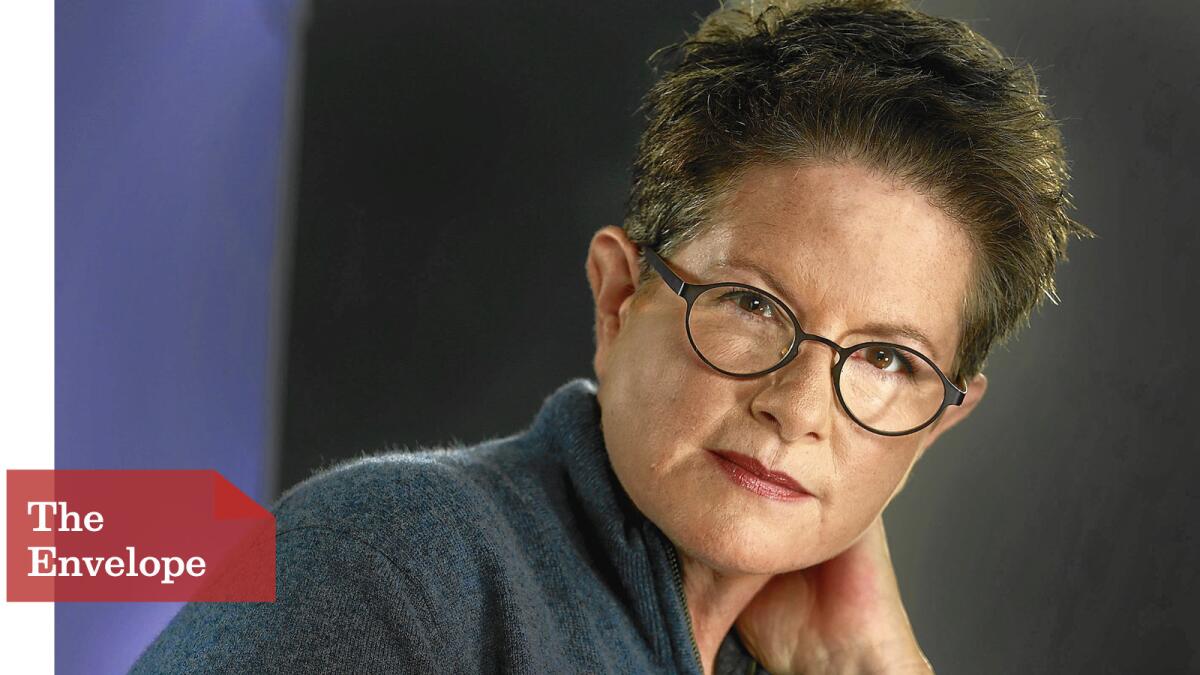The Envelope: Walking with ‘Carol’ for a decade and a half taught Phyllis Nagy to believe in miracles

Phyllis Nagy worked on the “Carol” screenplay over many years before resigning herself to its demise after the rights to the novel lapsed. Then came a call.
- Share via
When the opportunity to adapt “The Price of Salt” came to me in the late 1990s, I was young and foolish enough to have no fear of the challenges inherent in adapting Patricia Highsmith’s radical 1952 novel. After all, I’d known Highsmith pretty well over the last decade of her life. We’d even chatted about the book after she republished and re-christened it “Carol” in the early ‘90s. I thought it would be easy. It’s a deceptively slim volume, easily read in an evening or two. Light on plot and motored by the almost incantatory interior monologue of its young protagonist (Therese Belivet), the prose is functional and spare, in brilliant contrast to the passionate attachment — however restrained — between Therese and the object of her desire, Carol Aird.
SIGN UP for the free Indie Focus movies newsletter >>
What most excited me about tackling a script then, and still, was Highsmith’s refusal to engage in banal psychologizing about her characters’ sexual identities. Neither Therese nor Carol regrets the sexual choices each makes. Their identities are as natural to them as breathing. Neither attempts suicide. In fact, all of the novel’s lesbians — there is a third, Carol’s friend, Abby Gerhard — are more comfortable in their own skins than are the novel’s heterosexual, less settled characters.
I’d never read another novel like it, and its forward-thinking qualities still seem ahead of the times. Its delicate tone, its startling but understated subversion of cultural norms — these are the qualities I most cherished and fought to preserve through the writing process. But some of the same qualities that make the novel work so well are exactly the qualities that don’t work in screenplays: most notably, that Carol herself is a ghostly character, the scant details of her life relayed to the reader in shards, through Therese’s eyes — beautifully apt in the novel, so that the reader can visualize his or her own Carol. For film, a narrative life had to be created for Carol and a dynamic, shifting balance of power between the lovers substituted for the single point of view in the novel.
Eleven years later, we’d been through four drafts and double that in small revisions for directors and potential financiers who came and went. Every once in a while, Tessa Ross and Film4 — the other constants over the script’s development — guided us to keep the faith. I took other jobs, wrote and directed the film “Mrs. Harris” for HBO that was produced by Liz Karlsen and Christine Vachon (both producers of “Carol”). Yet “Carol” was the project I held closest to my heart.
And then the rights to the novel lapsed. I thought “Carol” had died. I resigned myself to its demise, however heartbroken I was. And I was fine with that. I’d lived with “Carol” longer than I’d lived with any lover; it was the first script I was paid to write. It taught me all I’d need to know — and some things I wish I never had to learn — about the craft of screenwriting. It taught me how to think on my feet and to tell the difference between how to fight for writing worth keeping rather than for writing I loved. I learned to be a diplomat in a decidedly undiplomatic industry.
I figured this was a great deal more than most writers are gifted with on any project and moved on. A year later, the call came from Liz Karlsen. She worked magic in persuading the Highsmith estate to grant her the option on the novel. She wanted to use my screenplay as the basis for the film; Tessa Ross, as ever, had our backs. Would I join them? I didn’t hesitate for a moment.
I said “no.”
I’d had enough, been through far too many false starts ending in disappointment. I was no longer the same writer who naively tackled the dark heart of the novel — I feared that, a decade gone, the writer I’d become would screw up everything that was fine about the script in the first place.
It took Liz a year to convince me to believe we could finally make this film. I took the leap and, much like Carol and Therese, we’ve never looked back. It was never easy, but it’s been something much better — it’s been miraculous.
More to Read
From the Oscars to the Emmys.
Get the Envelope newsletter for exclusive awards season coverage, behind-the-scenes stories from the Envelope podcast and columnist Glenn Whipp’s must-read analysis.
You may occasionally receive promotional content from the Los Angeles Times.






